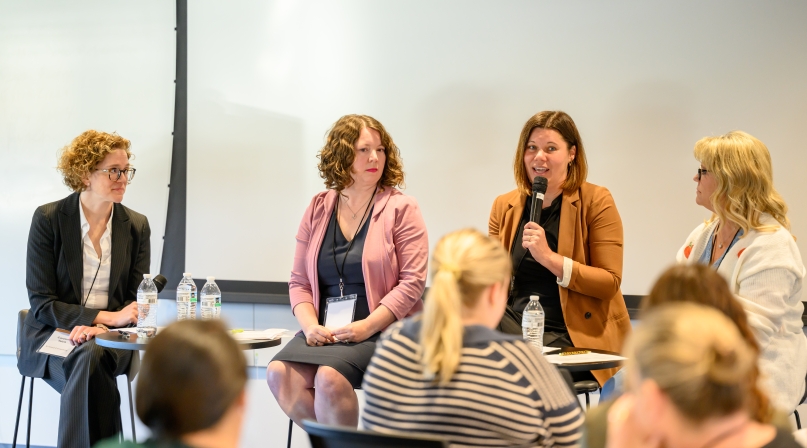Childcare means opportunities for economic growth

Key Takeaways
Childcare costs money. Not having childcare costs much more for a county’s economy.
The U.S. Chamber of Commerce Foundation pegs those total costs at $5.4 billion across the entire state of Ohio and $650 million just in Cuyahoga County.
“Inadequate access to affordable quality childcare is one of those big barriers [to labor force participation], and I don’t hear them talking very much about, but they should be,” said Caroline Taich, an economic consultant based in Cleveland. She heard the same problems confronting employers today during her travels in 2015.
She recalled hearing: “’I’ve got all these jobs, I can’t find the people that I need to fill them,’” she told an audience Oct. 1 during a panel discussion at a NACo Childcare Supply Network peer exchange in Cuyahoga County. “I can’t find the skills that I need. I need nurses, I need technicians, I need educators.
“‘If you can help me find the talent, the business growth will follow,’” they told her.
Lack of childcare options keeps would-be workers at home or at the very least, gives them an unpredictable schedule for work. Counties should consider public-private partnerships to help address the lack of affordable, available childcare, panelists said. If not just to help families out, then to help their economy fully realize its potential.
“What we heard in enrolling our residents in the workforce program was, ‘I don’t have childcare, I can’t do it,’” said Ashley Shaw, executive director of MidTown Cleveland, Inc. “‘I don’t care if it’s a six-week program and I can make $60,000 when I’m done with it,’” she recounted hearing, calling childcare a barrier to helping people connect with jobs and allowing families social mobility.
“From small mom-and-pop, immigrant-owned restaurants up to major Fortune 500 corporations, they cannot attract and retain talent today and that is one of all of our biggest barriers.”
Melissa Altman found out how much employers value childcare when her nursing home and childcare center were purchased by a chain of nursing homes two years ago. She’s the director of Children Services at the Play Time Early Childhood Enrichment Center, which serves families from six regional counties.
Her new bosses asked her why they should keep a childcare center despite its losses.
Altman said that, at least in what she’s seen from on-site childcare facilities, the children have a positive effect not only on productivity, but also morale.
“Happy people are happy, they enjoy coming into work,” she said. “They know that even if they’re not using the childcare center, the individuals are going to get to see the children. They’re going to get to be involved with the children, they’re going to hear laughter, they’re going to hear joy.”
“We have done research and surveys for individuals who use our childcare center… we retain 95% of our employees,” she said. “I tried showing them, not only is it a win-win for them and the employees, but our residents; 350 residents live there. Some of them never get to see a family member in a day, a week, a month sometimes,” but they get to see children and aren’t isolated.
Her bosses later recognized childcare’s value and are expanding their capacity.
Kara Porter, executive vice president at Starting Point, was surprised by what she heard from employers.
“We thought employers were not thinking about childcare. They are, and they don’t know what to do about it,” she said. “The problem that we need to solve is how do we make sure that they know that there are resources that can assist them around childcare and that they don’t have to be the ones to find the solution.”
Porter stressed that childcare, community development and economic development are indistinguishable.
“We should not be having community development and economic development conversations that don’t include childcare,” she said.
Starting Point is launching the MidTown Childcare Fund, a dollar-for-dollar match from the state Department of Children and Youth for employees in Cleveland’s MidTown neighborhood, though Shaw said that’s open to interpretation.
“Any private employer can be a part of this, if they don’t have a connection to MidTown, we’re helping to find them a connection to MidTown, because we really want folks to take advantage of this,” she said. “Employers are exploring the idea of offering $100 to $200 per month in child-care benefits that the state would then match. That translates to $200 to $400 a month for a family to help them afford childcare.”
Shaw said a three-way share among the state, employer and employee effectively splits the costs of childcare.
“They want employers to be a part of solving this problem, so I think we have a real opportunity to figure out ‘How do we engage businesses on this, if they haven’t thought about it?’” she said. “How do we get their voice at the table and help them advocate for policies that are going to be more effective for working families?”
Related News

Counties and Railroads: Shared Priorities for the Next Surface Transportation Bill
County leaders from across the country have a vital opportunity to ensure their infrastructure priorities are front and center.

House reintroduces bipartisan legislation to level playing field for rural communities
House reintroduced the Rural Partnership and Prosperity Act, bipartisan legislation intended to advance economic development in rural counties and overcome barriers to obtaining federal funding and resources.

Podcast: Eastern Tennessee counties invest in tourism during shutdown
Sevier County, Tenn. refused to let the government shutdown devastate its fall tourism draw—Great Smoky Mountains National Park. County Mayor Larry Waters describes the lengths he and his neighbors went to keep the park open. And NACo Chief Government Affairs Officer Mark Ritacco offers an outlook on what counties can take away from the shutdown and into the future.
Featured Initiative
Childcare Supply Initiative
The Childcare Supply Network supports local leaders in addressing childcare challenges. Participating counties are working with national experts to co-create sustainable solutions and financing strategies to strengthen local childcare systems in response to workforce needs.

